

Hello, I'm Brian...and welcome to my site. Since 1999, Brian's Sushi Page has been of service to thousands of people worldwide. From the sushi lovers seeking new & exciting sushi bars, to the unexperienced & curious with questions, I hope this page serves as a guide about this popular form of Japanese cuisine. Blending the serious art of sushi (via helpful information, terms, and beautiful pictures) with entertainment makes this page a unique experience on the web...and I hope you enjoy it.
Sushi - it is truly the ideal food. It
tastes great, and its good for you. Plus, there's a wide variety to enjoy...from
the raw to the cooked, to the traditional to the modern, from geographical
region to region, this is truly a love affair as well as an adventure for
the senses. Many people who haven't tried it say "Ew, raw fish",
and never try it based on the misconception that all sushi is raw. This
is simply a stereotype. Others try it for the first time, and don't like
it...more than likely because "they dove into the deep end of the pool
without feeling the water first." There are different ways to get over
this initial hurdle, which I'll go into further as you read on. Also, keep
in mind that sushi is not only food, but its an a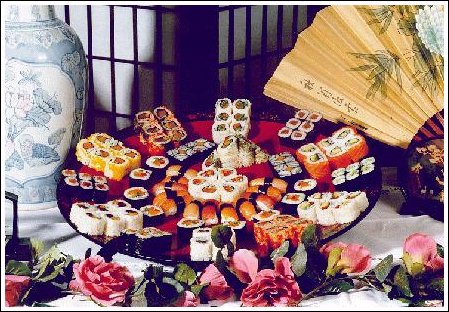 rt form. I mean,
c'mon...how many times have you looked down at a slice of pizza or a hamburger
and marveled at the beauty of it. Almost never, right? Sushi also has a
deep history of tradition, like many other forms of cuisine from various
ethnic groups. It can be prepared and enjoyed at home, picked up in ready-to-eat
trays at your local supermarket, or at sushi bars where the ambience can
range from the traditional Japanese atmosphere to the modern "brick,
neon, and rock n' roll" setting. The ways one can enjoy sushi is almost
infinite.
rt form. I mean,
c'mon...how many times have you looked down at a slice of pizza or a hamburger
and marveled at the beauty of it. Almost never, right? Sushi also has a
deep history of tradition, like many other forms of cuisine from various
ethnic groups. It can be prepared and enjoyed at home, picked up in ready-to-eat
trays at your local supermarket, or at sushi bars where the ambience can
range from the traditional Japanese atmosphere to the modern "brick,
neon, and rock n' roll" setting. The ways one can enjoy sushi is almost
infinite.
Originally, sushi started in China (and widely used throughout southeast Asia) to preserve fish by pickling and fermentation. However, sushi as we know it today took form in 18th century Japan...where seafood vendors in Osaka (then the capital of Japan) wrapped fish with rice and seaweed as a decorative edible package. This eventually became the roll style (or maki). The nigiri style originated in Tokyo, which consists of a piece of fish on a bed of rice. Taking America by storm during the 70s, there are now well over 5,000 sushi restaurants in the US. In 1998, $36,000,000 of seaweed to make sushi was sold...and there's an ever-growing demand for sushi chefs.
The preparation method is actually the true definition of sushi. When somebody translates sushi to raw fish, that's incorrect. Sashimi is raw fish, but not all sushi contains sashimi. Sushi can range from veggie rolls to spicy (fried) chicken rolls to egg omelette. There are also other ingredients in play - I once had a Hawaiian roll topped with macademia nuts. Now, lets learn a bit more about the two basic forms of sushi - nigiri and maki. Nigiri is often priced by the pair, and maki often by a set of 6...unless you specially request a handroll (temaki), which is one piece of cone-shaped seaweed, or nori, stuffed with rice and the key ingredients. Don't automatically assume that you will get more food by ordering maki instead of nigiri. Depending on the restaurant and chef, the nigiri cuts of sashimi may be thicker and generally more generous than the maki pieces. If you're new to the sushi experience, sushi may have a pungent odor...but don't let this scare you. It is not the fish you are smelling (unless you're in a low quality sushi bar)! The nori has a very unique aroma, and when combined with the vinegar prepared rice, your olfactory senses may be taken aback. Once you try sushi, and eat it regularly, the aroma is either non-existent or pleasurable. It is often mistaken that nori is made from sea kelp or ogo. However, its really a type of seaweed called lavar made on special farms. There is also another type of sushi called chirashisushi, which is rice and seafood served in a bowl - quite artistic and delicious.
Sushi school time - for the people out
there who are scared, but curious to try it, there are a few avenues you
can take to ease into the experience. First, try something neutral! The
California roll is often the most popular stepping stone to sushi, because
its all cooked, and its great tasting. The California roll is avocado, cucumber,
and crab wrapped in rice and nori. This will get the first-timer accustomed
to the smell of the rice and nori. In case the thought of eating seaweed
is holding someone back, he / she can request that the sushi chef substitute
peeled cucumber instead. This is how my brother started out eating sushi
years ago, and he's now a lover of different sushi varieties like me. Then
one can progress to the cooked su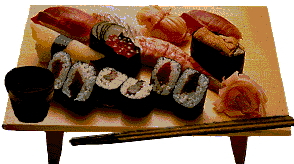 shi - shrimp, spicy chicken, or perhaps even eel (which is topped
with a sweet sauce)...and then when ready, perhaps, its time for the raw
- tuna, salmon, yellowtail, halibut, octopus, or a number of different types
of fish. A sashimi appetizer might be right up your alley to try different
sorts of fish before ordering a bunch of sushi you don't enjoy that puts
a dent in your wallet. Of course, the veggie rolls or the fried or baked
rolls can easily tempt the senses of the beginner as well. What do I tell
people? Well, I say "Go to your local grocery store where they have
the packaged sushi and pick up a California roll. It will set you back about
$3.00 - $4.00. Try it! If you don't like it, then atleast you know, and
didn't waste alot of money to experiment." An oriental buffet, with
a variety of sushi, may also be an affordable start - if you don't enjoy
the sushi, eat the other types of food offered and get your money's worth.
shi - shrimp, spicy chicken, or perhaps even eel (which is topped
with a sweet sauce)...and then when ready, perhaps, its time for the raw
- tuna, salmon, yellowtail, halibut, octopus, or a number of different types
of fish. A sashimi appetizer might be right up your alley to try different
sorts of fish before ordering a bunch of sushi you don't enjoy that puts
a dent in your wallet. Of course, the veggie rolls or the fried or baked
rolls can easily tempt the senses of the beginner as well. What do I tell
people? Well, I say "Go to your local grocery store where they have
the packaged sushi and pick up a California roll. It will set you back about
$3.00 - $4.00. Try it! If you don't like it, then atleast you know, and
didn't waste alot of money to experiment." An oriental buffet, with
a variety of sushi, may also be an affordable start - if you don't enjoy
the sushi, eat the other types of food offered and get your money's worth.
Ordering - at 99% of sushi bars out there,
its a bit different than ordering at other restaurants. Sushi orders are
taken by filling out a slip of paper and a short p![]() encil. No, this isn't for your miniature golf game afterwards...its
for ordering nigiri, maki, sashimi, and other specialties not found on the
menu. I find this incredibly easy with little room for error on both sides
(the customer and the restaurant). Given the fact that sushi is a delicacy
(and priced that way), its a good way to familiarize yourself with the selection
as well as the price. While we're on the subject of price, its worth mentioning
how much its going to cost for a dinner of sushi. Let me say that I'm a
big guy (cough, over 250 lbs), and my personal record is eating over $60.00
worth of sushi at one time. My experience has been that the sushi bars that
generally charge more offer bigger pieces in return, which might actually
cost less when the check arrives...because less is eaten. This will take
some research and overall familiarity with the sushi bars you frequent.
Sushi doesn't only have to be "the meal" - its often ordered as
an appetizer...which will put less of a dent in the wallet. A popular type
of sushi bar these days is the conveyer belt / floating boat style (pictured left)...where
various types of sushi are displayed on plates, offered to the patrons on
a moving belt or a flaoting sushi boat. At the end of the meal, one pays
by the number of plates, differing in color according to price range which
should be clearly outlined in the menu or posted on signs.
encil. No, this isn't for your miniature golf game afterwards...its
for ordering nigiri, maki, sashimi, and other specialties not found on the
menu. I find this incredibly easy with little room for error on both sides
(the customer and the restaurant). Given the fact that sushi is a delicacy
(and priced that way), its a good way to familiarize yourself with the selection
as well as the price. While we're on the subject of price, its worth mentioning
how much its going to cost for a dinner of sushi. Let me say that I'm a
big guy (cough, over 250 lbs), and my personal record is eating over $60.00
worth of sushi at one time. My experience has been that the sushi bars that
generally charge more offer bigger pieces in return, which might actually
cost less when the check arrives...because less is eaten. This will take
some research and overall familiarity with the sushi bars you frequent.
Sushi doesn't only have to be "the meal" - its often ordered as
an appetizer...which will put less of a dent in the wallet. A popular type
of sushi bar these days is the conveyer belt / floating boat style (pictured left)...where
various types of sushi are displayed on plates, offered to the patrons on
a moving belt or a flaoting sushi boat. At the end of the meal, one pays
by the number of plates, differing in color according to price range which
should be clearly outlined in the menu or posted on signs.
I found some very helpful tips while reading a recent restaurant review in The Weekly Planet, written by Sara Kennedy. Andrew Moos, founder of The Tampa Bay Sushi Society & owner of GoSushiCatering, offered some insight to further enjoy your experience.
Let's go into the wide variety of types of sushi. We'll start with the nigiri...
 tuna (toro) is considered
the higher quality fish that just melts in your mouth.
tuna (toro) is considered
the higher quality fish that just melts in your mouth.
When it comes to the rolls, the more "popular style" among chefs is to wrap the main ingredients in the seaweed, packing the rice along the outside...however, you may find chefs putting the seaweed on the outside of the roll - don't let this shock you. It just depends on where and how they learned their craft. Also, you can request a "hand roll" for any roll, known in Japanese as "temaki". Its easy to remember, because "karate" means "open hand", and "temaki" is the hand roll (pictured below right). Rolls vary from state to state and restaurant to restaurant. I remember out in L.A., I was having a sushi lunch with my dad years ago...and this particular bar had a Tarzana Roll (Tarzana is in the San Fernando Valley) - which was the California Roll, but instead of crab, they used yellowtail. You will find some comfortable favorites when you travel, but I love the diversity that the chefs use to be inventive and creative! Never be afraid to try something new! During one of my birthday parties at a trendy sushi spot, I tried an amazing roll with banana tempura and eel...which was heavenly. Some sushi chefs, or amateur makers, will testify that roasting the sesame seeds will add a toasty flavor to their rolls. This might be available for request at your next trip to the sushi bar.
Now, let's dive into the maki...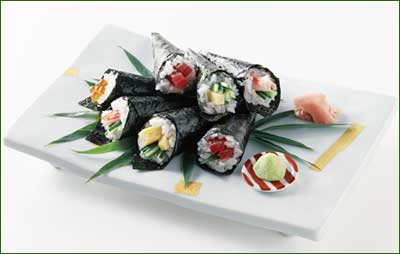
Obviously, I just touched the tip of the
iceberg with the varieties of nigiri and maki, but this should give you
an idea of the most popular types. I can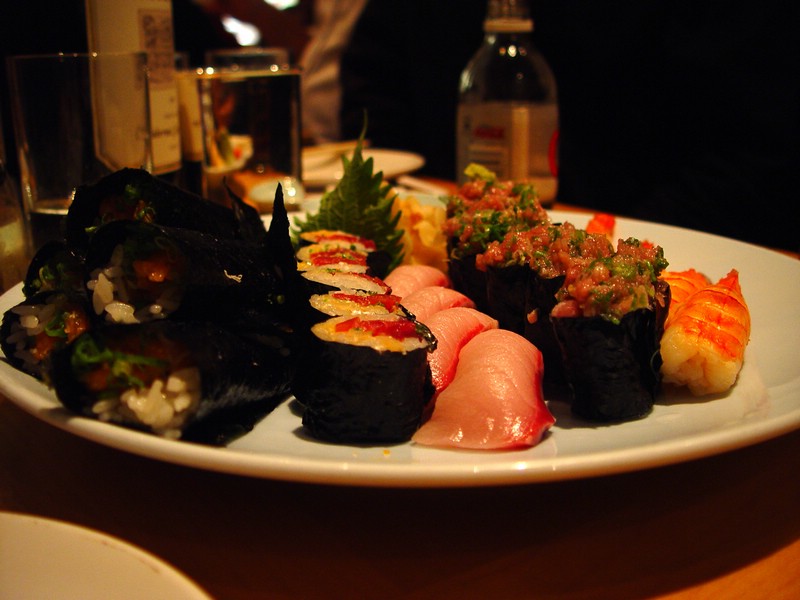 't personally write about every type, as I haven't tried everything
(yet).
't personally write about every type, as I haven't tried everything
(yet).
When sushi is served, there will be some interesting items on the tray. The green putty-like substance is called wasabi, often referred to as Japanese horseradish (which, scientifically, is false...but who am I to question). This is very spicy hot stuff, and its only to be used sparingly as a condiment for your pieces or combined with other ingredients into a ponzu sauce for dipping. Sushi chefs usually add a touch of this between the fish and rice...to enhance the flavor, not to overpower. However, the sushi chef will adhere to requests to leave it off an order. Also on the tray is thinly sliced ginger, used to cleanse the palate between different pieces (and types) of sushi. Wasabi & ginger are purely used based on personal preference - some like sushi as is, some like it with condiments. Ponzu sauce is a dipping sauce - which blends soy sauce, rice wine vinegar, wasabi, and lemon (or lime).
Sushi etiquette is extremely important as part of the dining experience. Interestingly enough, I found some advice written in Playboy's advisor section (See ladies, some of us men really do read the articles). Anyway, here's what they had to say. "Never dip your sushi rice-side, and don't soak it - the sauce should compliment fish, not kill the flavor. It's best to eat each piece in one bite, but in the West that's not always practical because sushi tends to be larger. Never pass food with your chopsticks; in Japan, this resembles a Buddhist ritual in which bone fragments from a cremated body are passed at a funeral. Instead, offer the plate. It's OK to pick up sushi with your fingers, but always use chopsticks for sashimi. When you are not using your sticks, place them on the small, decorative hashi oki. If you take food from a shared plate, turn the sticks around so you're not using the ends that you put in your mouth. It's bad form to smoke...and while you should leave a tip on the bar for the chef, keep in mind that the people who handle the food never touch the money." Thanks for the valuable info.
For those health nuts and dieters out there
(you know who you are), sushi is an ideal treat! According to the Weight
Watchers 123 Points food guide...4 pieces of sushi nigiri
equals to 3 points, and 4 pieces of maki (with sashimi) equals 2 points.
Maki with just vegetables is just 1 point for 4 pieces. What a deal! The
highest calorie sushi, which is the fatty tuna (toro), averages about 80
calories a piece. Other sushi averages about 50 calories a piece. The f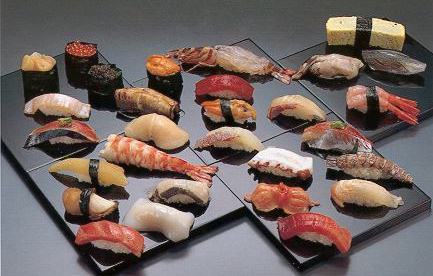 at in the seafood
are unsaturated fats, which lower the risk of heart disease. The seaweed
(nori) is very high in vitamin A and other vitamins and minerals, according
to the USDA. Now on to the Mayo Clinic's comments...sashimi is a good source
of protein and can be a good source of Omega-3 fatty acids. Tofu (bean curd)
provides calcium, and vegetables are a great source of providing disease-preventing
phytochemicals. Nori (seaweed) is rich in iodine, and of course, rice provides
complex carbohydrates. I am clueless about carb information - sorry fellow
Atkins dieters.
at in the seafood
are unsaturated fats, which lower the risk of heart disease. The seaweed
(nori) is very high in vitamin A and other vitamins and minerals, according
to the USDA. Now on to the Mayo Clinic's comments...sashimi is a good source
of protein and can be a good source of Omega-3 fatty acids. Tofu (bean curd)
provides calcium, and vegetables are a great source of providing disease-preventing
phytochemicals. Nori (seaweed) is rich in iodine, and of course, rice provides
complex carbohydrates. I am clueless about carb information - sorry fellow
Atkins dieters.
Health risks? Well, aren't there risks
to everything these days (bottled water, vegetables with insecticides)?
Okay, okay...first things first: pregnant women, stay away. There are parasite
and toxin concerns when eating raw fish, according to the FDA Center for
Food Safety and Applied Nutrition Guidelines. Toxins can be produced by
spoilage bacteria on fish that may cause headaches and itchy skin...as well
as your typical gastrointestinal problems, such as vomitting and diarrhea.
According to The Mayo Clinic, reactions could range from hives to shock...a
bit paranoid, are we?!? I've also heard reports that salmon has a risk of
tapeworms. This news story I saw, believe it or not, honestly said "although
it may affect the flavor, experts recommend freezing or cooking the sushi
before eating." Cooking...yeah, right!!! Just remember, freshness
is key! Fresh fish has a mild aroma - strong fishy or ammonia-like smells
should send alarm bells. The health aspect is a non-issue in my mind. In
most sushi bars around the country, the professional chefs get the freshest
fish from around the world...and prepare it in the most sanitary conditions.
This is one reason why I don't prepare my own homemade sushi; I just prefer
to leave it to the pros! Another article showed studies that seared &
cooked tuna are more dangerous than raw tuna. Histamine poisoning (which
is often confused with simple food poisoning because of its similar symptoms)
can be a risk with cooked tuna you eat in restaurants (tuna burgers, seared
tuna, etc); even cooking the tuna well done may kill bacteria, but the risk
of histamine poisoning still exists. Raw tuna for sushi comes from the best
cut of the fish, the filet...and is stored at freezing temperatures in h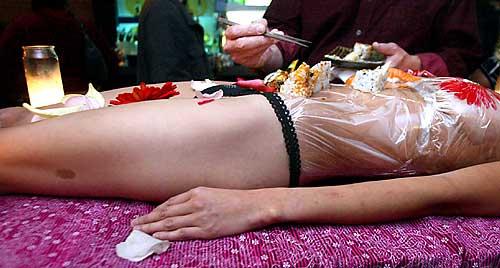 uge pieces. Since it stays that temperature
until right before serving, the risk is greatly reduced. Want more? The
fat in certain kinds of fish may be reduce risks of cancer, according to
a recent MSNBC article about the Okinawan diet (where life span is greater
with a higher percentage of people over 100 than anywhere else in the world).
It states that further studies need to be done.
uge pieces. Since it stays that temperature
until right before serving, the risk is greatly reduced. Want more? The
fat in certain kinds of fish may be reduce risks of cancer, according to
a recent MSNBC article about the Okinawan diet (where life span is greater
with a higher percentage of people over 100 than anywhere else in the world).
It states that further studies need to be done.
Here are some interesting facts about sushi (for you trivia nuts)...
 ".
".
|
|
Please, feel free to e-mail me with any suggestions, comments, questions, or info that would further enhance any section of my site. Its readers, like yourself, that keep this page entertaining and informative to other readers...and its purely my pleasure to bring it to you. So, visit the other sections of the page, sign the guestbook, and bookmark it for future updates. Thanks again.